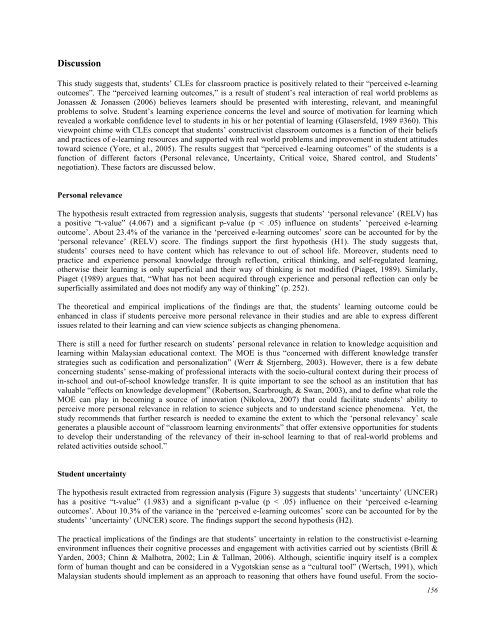October 2011 Volume 14 Number 4 - Educational Technology ...
October 2011 Volume 14 Number 4 - Educational Technology ...
October 2011 Volume 14 Number 4 - Educational Technology ...
You also want an ePaper? Increase the reach of your titles
YUMPU automatically turns print PDFs into web optimized ePapers that Google loves.
Discussion<br />
This study suggests that, students’ CLEs for classroom practice is positively related to their “perceived e-learning<br />
outcomes”. The “perceived learning outcomes,” is a result of student’s real interaction of real world problems as<br />
Jonassen & Jonassen (2006) believes learners should be presented with interesting, relevant, and meaningful<br />
problems to solve. Student’s learning experience concerns the level and source of motivation for learning which<br />
revealed a workable confidence level to students in his or her potential of learning (Glasersfeld, 1989 #360). This<br />
viewpoint chime with CLEs concept that students’ constructivist classroom outcomes is a function of their beliefs<br />
and practices of e-learning resources and supported with real world problems and improvement in student attitudes<br />
toward science (Yore, et al., 2005). The results suggest that “perceived e-learning outcomes” of the students is a<br />
function of different factors (Personal relevance, Uncertainty, Critical voice, Shared control, and Students’<br />
negotiation). These factors are discussed below.<br />
Personal relevance<br />
The hypothesis result extracted from regression analysis, suggests that students’ ‘personal relevance’ (RELV) has<br />
a positive “t-value” (4.067) and a significant p-value (p < .05) influence on students’ ‘perceived e-learning<br />
outcome’. About 23.4% of the variance in the ‘perceived e-learning outcomes’ score can be accounted for by the<br />
‘personal relevance’ (RELV) score. The findings support the first hypothesis (H1). The study suggests that,<br />
students’ courses need to have content which has relevance to out of school life. Moreover, students need to<br />
practice and experience personal knowledge through reflection, critical thinking, and self-regulated learning,<br />
otherwise their learning is only superficial and their way of thinking is not modified (Piaget, 1989). Similarly,<br />
Piaget (1989) argues that, “What has not been acquired through experience and personal reflection can only be<br />
superficially assimilated and does not modify any way of thinking” (p. 252).<br />
The theoretical and empirical implications of the findings are that, the students’ learning outcome could be<br />
enhanced in class if students perceive more personal relevance in their studies and are able to express different<br />
issues related to their learning and can view science subjects as changing phenomena.<br />
There is still a need for further research on students’ personal relevance in relation to knowledge acquisition and<br />
learning within Malaysian educational context. The MOE is thus “concerned with different knowledge transfer<br />
strategies such as codification and personalization” (Werr & Stjernberg, 2003). However, there is a few debate<br />
concerning students’ sense-making of professional interacts with the socio-cultural context during their process of<br />
in-school and out-of-school knowledge transfer. It is quite important to see the school as an institution that has<br />
valuable “effects on knowledge development” (Robertson, Scarbrough, & Swan, 2003), and to define what role the<br />
MOE can play in becoming a source of innovation (Nikolova, 2007) that could facilitate students’ ability to<br />
perceive more personal relevance in relation to science subjects and to understand science phenomena. Yet, the<br />
study recommends that further research is needed to examine the extent to which the ‘personal relevancy’ scale<br />
generates a plausible account of “classroom learning environments” that offer extensive opportunities for students<br />
to develop their understanding of the relevancy of their in-school learning to that of real-world problems and<br />
related activities outside school.”<br />
Student uncertainty<br />
The hypothesis result extracted from regression analysis (Figure 3) suggests that students’ ‘uncertainty’ (UNCER)<br />
has a positive “t-value” (1.983) and a significant p-value (p < .05) influence on their ‘perceived e-learning<br />
outcomes’. About 10.3% of the variance in the ‘perceived e-learning outcomes’ score can be accounted for by the<br />
students’ ‘uncertainty’ (UNCER) score. The findings support the second hypothesis (H2).<br />
The practical implications of the findings are that students’ uncertainty in relation to the constructivist e-learning<br />
environment influences their cognitive processes and engagement with activities carried out by scientists (Brill &<br />
Yarden, 2003; Chinn & Malhotra, 2002; Lin & Tallman, 2006). Although, scientific inquiry itself is a complex<br />
form of human thought and can be considered in a Vygotskian sense as a “cultural tool” (Wertsch, 1991), which<br />
Malaysian students should implement as an approach to reasoning that others have found useful. From the socio-<br />
156

















